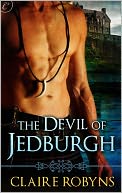 The Devil of Jedburgh is a title granted by superstition to Arran Kerr in Claire Robyns’ historical romance set in the Scottish Lowlands during Mary, Queen of Scots reign. There are no actual devils or demons involved. But if you have a taste for historical romance, this story is wickedly good.
The Devil of Jedburgh is a title granted by superstition to Arran Kerr in Claire Robyns’ historical romance set in the Scottish Lowlands during Mary, Queen of Scots reign. There are no actual devils or demons involved. But if you have a taste for historical romance, this story is wickedly good.
Breghan McAllen’s father has promised Arran Kerr of Ferniehurst that he will give his daughter to him in marriage. The marriage will unite two of the strongest families in the Scottish Lowlands, families that are both loyal to Mary, Queen of Scots.
Bree is 19 years old, and has been indulged by her parents all of her life. She is the youngest of her parents’ 13 children, and the only daughter. She’s a little spoiled and a little wild. And she’s scared to death of marrying Arran Kerr.
Not because she’s afraid of men (she has 12 older brothers, after all). She’s not afraid of marriage itself. Or sex. She’s still a virgin, which is expected in that time for a woman of her class, but again, 12 older brothers, and there are horses and cattle and sheep. Some of her older brothers are married. She’s not stupid. Far from it.
But Arran Kerr is known far and wide as the Black-Hearted Kerr. The Curse of Roxburgh. Or the Devil of Jedburgh.
Breghan does not want to marry the demon-spawn who acquired all those horrible names.
Arran, on the other hand, wants to marry the daughter of Laird McAllen’s wife. Not because he’s ever met the Lady McAllen. Or her daughter. But because Lady McAllen gave her Laird 12 strapping sons and lived. Arran’s met some of the sons, and the Laird himself. Arran assumes the Lady must be a big, buxom woman to survive that much childbearing. And that’s just what he needs. He doesn’t care what her daughter looks like.
All those nicknames? Arran can be the very devil in battle. But that’s not unusual for the Scottish borderlands during the 1500s. His real problem is that he believes there is a curse on the Kerrs. He is the last of the Kerrs of Ferniehurst. Because of the curse. The curse that all of the Kerr women, wives or not, die in childbirth with the baby.
So the rumor that Arran killed his mother? Well, it’s true. After a fashion. His mother died in childbirth. His birth. Not that death in childbirth was uncommon in the 1500s.
But Arran believes in the curse. So he wants to marry McAllen’s daughter, thinking that the McAllen women must be veritable brood mares, not just capable of bearing an entire clan all by themselves, but looking like it, too. Arran figures he’ll just blow the candle out every night.
That’s what he tells Breghan when he meets her. While she’s running away–from marrying him. She tells him that her name is “Bree” and claims to be, well, her own servant. And Arran takes one look at her and falls, well, deeply in lust, at the very least. But decides he can’t have her, even to dally with, because of that curse. Because Bree isn’t big and buxom. She’s feminine enough, but on the slim and athletic side. (We’d call her a tomboy today.)
In the morning Arran arrives at the McAllen home, after Bree has run away from him. Again. Only to discover that 1) Bree is the woman he was supposed to marry and 2) the Lady McAllen is built along the same lines as her daughter, in spite of that fine brood of strapping sons, and 3) he wants Bree anyway, in spite of, or because of, her defiant spirit. At least for a while, and he’ll have his sons with some broodmare of a woman, later.
Arran and Bree are handfast by the priest who was supposed to marry them. A handfast was a trial marriage. A year and a day, unless there was a child. (Handfastings did exist, and were quite legal.)
Arran and Bree go into the marriage with very different expectations. Arran expects to have Bree, just for a while. Then find some other woman, and quite probably have her die in childbirth. He already cares too much for Bree to let her die bearing his child.
Bree has Arran’s word that after the year is over, he will let her go, and let her marry whoever she wishes. Her dream is to live in Edinburgh, to live a relatively civilized life in the city and be near Court.
So Arran brings Bree to Ferniehurst as his handfast Lady. And Bree discovers that the fearsome “devil of Jedburgh” is not quite as black as the rumors have painted him. But the Court in Edinburgh, that, on the other hand, might be worse than any evil she ever imagined.
Escape Rating B+: There’s a lot going on in this love story. It’s complicated and it mixes in some very real history from a period that has always fascinated me. Which is what made me get seriously sucked in to the story.
First there’s the love story between Arran and Bree. These are two really strong-willed people. They both think they can have their trial marriage and walk away unscathed after the “year and a day”. Watching them learn otherwise is a major part of the fun in this story. They both need to learn a few lessons before they’re right for each other. But watching their journey is very much worth reading!
The icing on the cake for me was the events that occur in Edinburgh. This story ties into some of the real history of Mary, Queen of Scots and her second husband Henry, Lord Darnley. This period of Scottish and English history has always been one of my favorites, so visiting again was a special treat for me, even if Arran’s and Bree’s involvement with the Court was somewhat problematic for them.
For more of my thoughts on this book see this post at Book Lovers, Inc.








